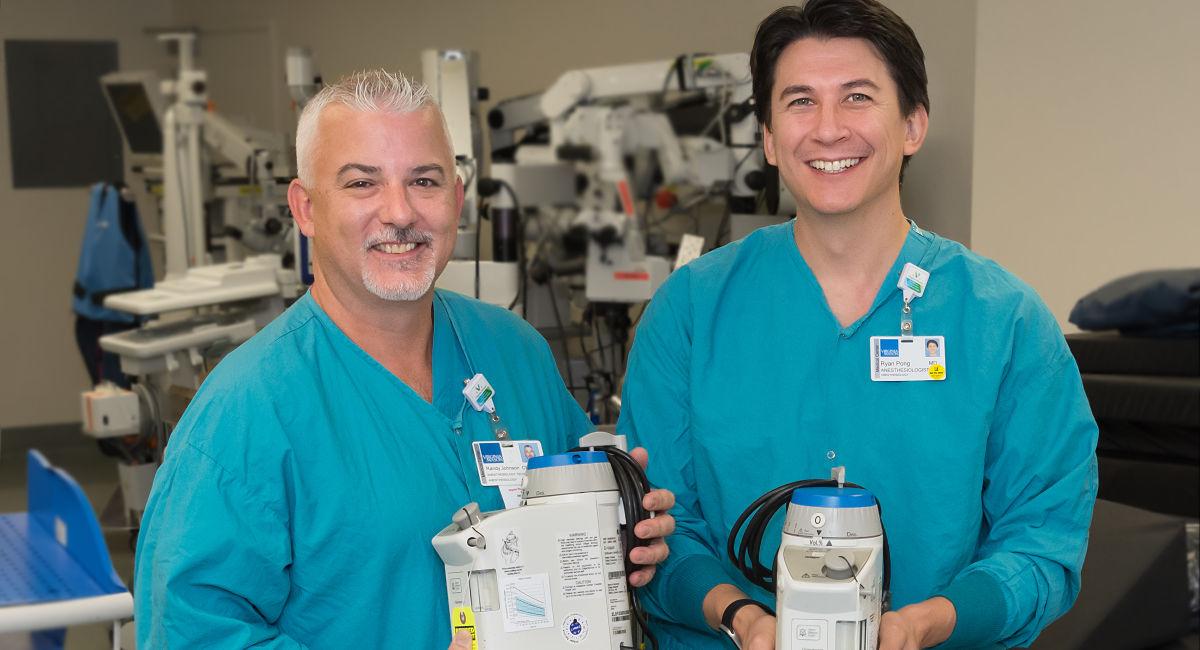When Virginia Mason’s anesthesia technician Randy Johnson and staff anesthesiologist Dr. Ryan Pong learned that desflurane had a global warming potential 20 times greater than its alternative gases in 2015, they decided to work together on persuading their colleagues to reduce the use desflurane in favor of its alternatives. Through casual but persistent conversations over a five-year period, the duo ultimately convinced every member of their department that other gasses could work without harming patient care. Their success culminated in September 2019 when Virginia Mason Medical Center completely eliminated desflurane use.
A recent newsletter from Virginia Mason highlighted the effort sharing, “an added benefit of eliminating desflurane is cost. Alternative gasses are far less expensive, and desflurane’s dedicated vaporizers are no longer needed. The medical center has saved more than $30,000 each year since initiating the switch. But the real motivation for the anesthesia team and the organization is having a new way to protect the environment. Desflurane lasts for 14 years in the atmosphere, while the alternative, sevoflurane, breaks down in about one year.”
There are few opportunities for a clinician to have an impact on a facility’s direct, scope I greenhouse gas (GHG) emissions; working with anesthesia providers is one. The most common inhaled anesthetic gases in the United States are isoflurane, sevoflurane, desflurane, and nitrous oxide. Anesthetic gases are greenhouse gases – largely un-metabolized by the patient, scavenged from the OR, and vented directly off the hospital roof into the air.
These waste anesthetic gases can account for 5% or more of a facility’s GHG footprint or 51% of an operating room’s GHG emissions.
Anesthetic gases are necessary for patient care, however, the American Society of Anesthesiologists Environmental Task Force has a series of peer-reviewed research and recommendations that highlight effective strategies for reducing the footprint of these gases without compromising patient care.
- Educating providers on the costs and environmental impact of anesthetic gases to support behavior change is critically important.
- Using low fresh gas flow rates reduces the amount of anesthetic gases used and vented. Newer anesthesia machines monitor and provide alerts around fresh gas flow rates to support providers.
- Considering intravenous or regional techniques instead of inhaled anesthetics.
- Establishing a baseline for anesthetic gases and tracking use.
- Reducing the use of desflurane and nitrous oxide.
Often, providers are unaware that their anesthetic gas choice has such a significant environmental and financial impact. Data is key – working with anesthesia gas vendors to pull a purchasing report or using the organization’s EMR to track anesthetic gas usage and determine GHG emissions helps to benchmark impact. Digging deeper into the data and highlighting anesthetic gas consumption by anesthesia provider can be a powerful way to encourage more judicious anesthetic gas choice and use. The Practice Greenhealth anesthetic gas toolkit has a data collection and tracking tool to support these efforts.
Desflurane is often the most expensive anesthetic agents and has the highest global warming potential (GWP). Nitrous oxide has a much lower GWP but persists in the atmosphere for over 100 years. By focusing on reducing the use of desflurane, facilities can significantly reduce their overall GHG emissions. Some hospitals eliminated desflurane simply as a cost-containment strategy, with the added benefit of reducing their environmental footprint. Some opt for a phased approach to elimination – removing desflurane vaporizers from operating rooms to reduce convenience and use (but having them available if necessary), while other facilities simply phased out and completely eliminated the use of desflurane.
“This is one of those sweet spots where sustainability and cost savings go hand-in-hand,” says Advocate Aurora Health’s sustainability manager Katie Wickman. “At first, I wasn't sure how to approach the project within my organization, but I ended up finding a great partner in our clinical effectiveness team – a team that focuses on safe, quality, cost-effective patient care. I saw a greenhouse gas reduction opportunity, and they saw a safe, clinically-effective standardization and cost-savings opportunity.”
That partnership opened doors, allowing Wickman to present to the health system’s various anesthesia provider groups on the environmental impacts of anesthetic gases and recommendations on eco-friendly anesthesia care by their professional organizations.
“While the potential financial savings were appealing, they were secondary to the environmental benefits of the initiative. It was really our conscientious anesthesiologists that evaluated their practices and made changes where it made sense,” says Wickman.
Since the program’s inception in 2017, Advocate Aurora Health has reduced emissions from volatile anesthetic gases by 55%, saving the organization over $1 million.
Nearly 70 Practice Greenhealth member hospitals have eliminated or are working to eliminate desflurane. The following U.S. Health Care Climate Council members have eliminated or are working to eliminate the harmful anesthetic gas from their facilities:
- Advocate Aurora Health
- Boston Medical Center
- Cleveland Clinic
- HealthPartners
- Providence St. Joseph Health
- Rochester Regional Health
- Seattle Children’s
- Virginia Mason
For more information, check out the Practice Greenhealth anesthetic gas toolkit and the American Society of Anesthesiologists’ Environmental Sustainability for Anesthesia Practice.
